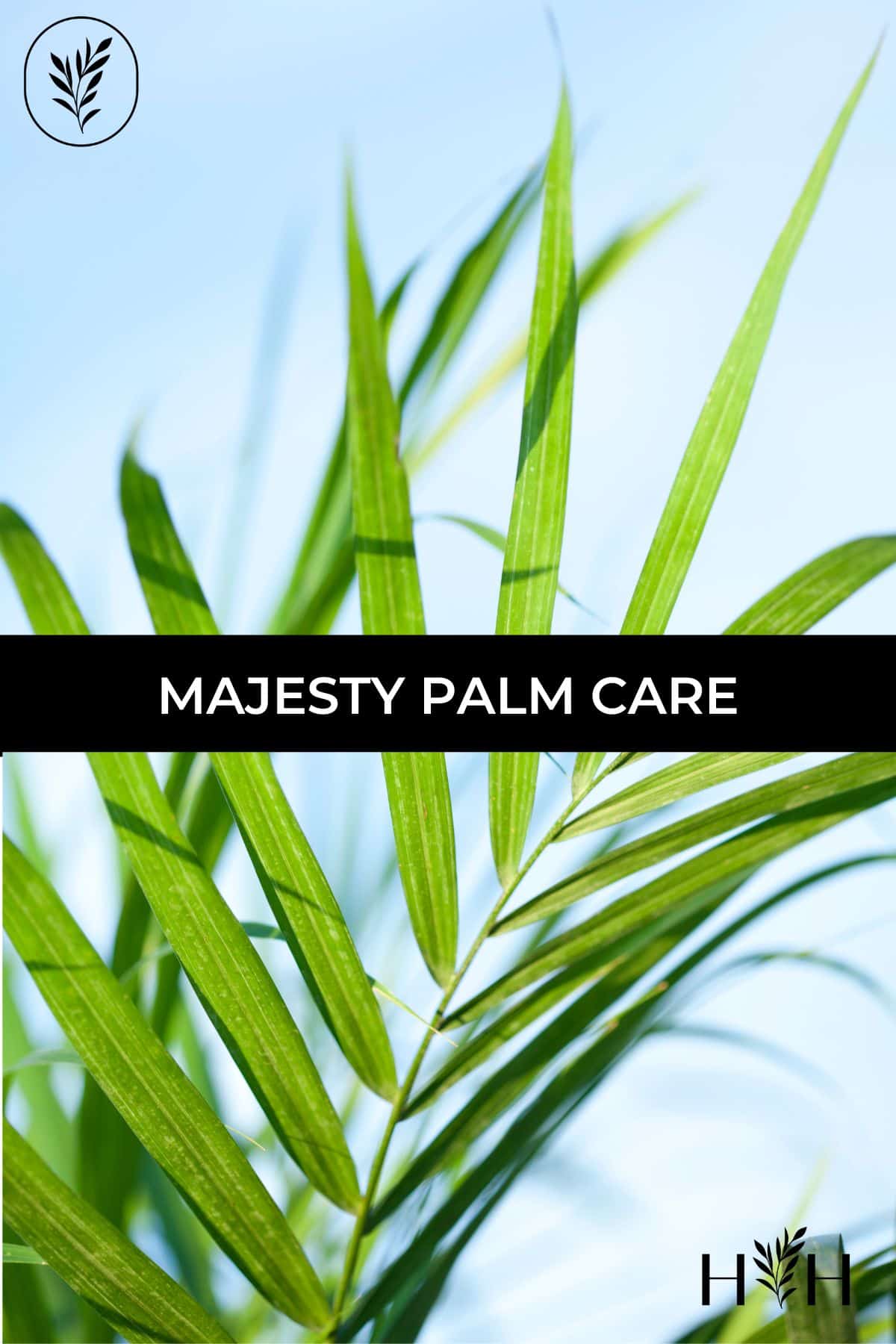Majesty palms are beautiful plants, whether you grow them indoors or outside. That said, they can be one of the tricker houseplants to care for.
Majesty Palms require frequent watering and grow best in warm, bright locations. These tropical trees thrive in moist soil rich in nutrients and are generally fertilized with a slow-release organic fertilizer in the spring and summer. Majesty Palm can be grown in full sun as long as the plant has been acclimated to direct sunlight and the roots have consistent access to fresh water. The fronds of this plant may turn brown at the tips when Majesty Palm is grown in dry environments such as indoors over the wintertime. These slow-growing trees are usually repotted every few years in the springtime.
Read on to learn all about caring for Majesty Palms at home!

Majesty palm care basics
Majesty Palm (Ravenea rivularis) is a tropical palm tree species native to Madagascar. These trees can grow over 50 feet tall when planted in the ground outdoors, developing a thick trunk as they mature. Indoor-grown Majesty Palms generally reach a maximum height of about 10 feet tall and rarely develop a trunk, with the base of the plant as a crown from which fronds emerge.
Majesty Palm is a popular houseplant as these trees are large and attractive indoors and are also non-toxic to dogs and cats (source: ASPCA). That said, their growing requirements, especially the need for frequent watering and high humidity, make them more challenging to care for in an indoor environment than some other types of palms commonly grown as container plants.
Sunlight requirements for Majesty palm
Majesty Palms are native to a hot, sunny climate and can be grown outdoors in full sunlight provided they are properly acclimated to direct light and have enough water. Indoors, they grow best where they have access to sunlight from windows and potentially from supplemental artificial light in low-lit homes. Plants grown in bright light will typically require more frequent watering and feeding than those grown in medium indoor light.
Majesty Palm trees grow best in warm, moist, bright environments. I keep my largest majesty palm in a bright corner beside a sunny window near the kitchen where it can receive ample light and humidity.
Watering Majesty palm plants in pots
Majesty Palm trees are generally watered more often than many other houseplants. These tropical trees grow best in soil that is consistently moist (but not soggy with stagnant water). Majesty palm trees in nature grow beside streams and are accustomed to having wet roots as long as the water is fresh and contains oxygen.
In a household environment, this generally means watering your Majesty Palm a few times each week. Let the top inch of soil dry out, but try not to let the majority of the soil dry out completely. Water quite frequently in the spring through to early fall, but decrease watering during the winter when the days are shorter. Try not to let the soil dry out completely in the winter – a small decrease in water is all that is needed. If the soil becomes crusty at the top over time, take a chopstick or a kitchen skewer and poke holes in the top few inches of soil to allow water to seep into the soil rather than running down the sides of the desiccated root ball.
Young Majesty Palms that are grown as potted houseplants generally do not yet have a trunk and instead have a crown of leaves at the base. When watering majesty palms, pour the water onto the soil around the base of the plant. Avoid pouring water in or around the crown of the plant, as this can lead to rot. Rot is particularly common at the tips of new fronds which may be damaged by rot before they have a chance to emerge and unfurl. Since these trees are slow-growing and don’t produce too many fronds each year, it makes sense to avoid watering the base of the fronds completely.
Humidity preferences of Majesty palm plants
Moderate to high air humidity is important for majesty palms. These trees thrive in moist, humid air just as much as they thrive in moist soil. Indoors, this generally means positioning your tree in the most humid area of your house. In dry climates, a humidifier is recommended for increasing indoor humidity. Misting is generally ineffective and can lead to water spots on the leaves that are difficult to remove.
Temperature requirements for Majesty palm
Majesty Palms grow well at comfortable indoor temperatures. They can be grown outside in frost-free climates. Avoid letting these trees freeze as even established outdoor trees can be significantly damaged or killed by below-freezing temperatures. In cold climates, avoid transporting potted trees during the winter or take measures to protect them from the cold.
In our home, I use a whole-house humidifier to keep the air at a minimum of 40%-50% humidity during our dry winter season. This keeps the leaves from becoming overly dry (and is more comfortable for me as well) and reduces the occurrence of brown tips.
Majesty Palms grown indoors do well when taken outdoors for a few months in the summer. Place them in a sheltered spot out of direct sunlight. The plants will appreciate the fresh air and higher light levels (although you’ll likely have to water more often).
Repotting Majesty palm plants
Majesty Palm plants are best repotted in the springtime. These slow-growing plants generally don’t grow fast enough to require annual repotting, and are usually repotted only every 2-3 years. Use a light, well-draining potting mix and a pot that has an effective drainage hole. These heavy plants need a large planter to support their root system.
Majesty Palm trees are quite tall for indoor plants and are susceptible to tipping over when they are in lightweight plastic growers’ pots. To counteract them tipping over, sometimes they are potted quite deep in their planter. Check new Majesty Palms to see if you can see the base crown where the fronds all attach together. If fronds are appearing up from the soil, the crown is likely buried which can lead to rot. If the crown isn’t visible, remove the root ball from the pot, brush off the soil, and repot it with the soil line below the crown so the crown is visible above the soil.

Fertilizing Majesty palm
Majesty Palms can be fed regularly in the spring and summer with a slow-release organic fertilizer. Most palm fertilizers have a relatively low amount of phosphorus (P) and a relatively high amount of potassium (K) to support the plant in growing lush green fronds. One of the most popular natural fertilizers for majesty palm is Espoma’s Palm-Tone. Here is an article listing some excellent fertilizers for Majesty Palm plants.
I use a granular palm fertilizer that is spread onto the moist soil around the base of the plant and then watered in. As with watering, avoid getting fertilizer on the base of the plant itself. Different fertilizer products have different application methods and frequencies. I look for palm fertilizers that contain added organic matter like compost. I also choose products approved by the Organic Materials Review Institute (OMRI) if possible.
Pruning Majesty palm
Pruning Majesty Palm should be minimal. Pruning is mostly limited to removing older fronds after they become yellowed to improve the tree’s appearance. Majesty palms typically grow in a shapely symmetrical habit and don’t need to be pruned for shape. These slow-growers don’t put out too many fronds each year, so avoid removing healthy fronds if at all possible as the plant needs them for photosynthesis.
Propagating Majesty palm
Majesty Palms are most commonly propagated from seeds, but can occasionally be vegetatively propagated by division. These trees are not propagated by cuttings. Propagation is infrequent as the plants grow slowly, may not produce more than a single stalk, and may only need repotting every 2-3 years.
Occasionally, a young Majesty Palm from the store will have more than one trunk coming out of the soil. What sometimes happens is that a nursery might pot up 2-3 separate trunks into a single planter to give the tree a fuller appearance. In this case, the separate trunks can be repotted into separate planters.
Pests affecting Majesty palm plants
Majesty Palm is susceptible to pests such as fungus gnats, scale, and spider mites when grown indoors. I like to spray new plants from the store with an organic insecticidal soap to decrease the amounts of any pests imported with the plant. It’s also a good idea to keep new plants from the store separated from your other houseplants for a few weeks to avoid spreading new pests.
Since this plant thrives in moist soil, it can become a target for fungus gnats. Let the top inch of soil dry out between waterings, and be sure to decrease watering frequency in the winter. Use sticky sticks to check for the presence of gnats, and if any are caught on the trap, treat with an organic insecticide.
Diseases affecting Majesty palm
Majesty Palm plants are not terribly prone to disease, but can suffer from root rot. Root rot is a plant disease in which moist, stagnant conditions at the base of the plant that lead to ill health. This is most commonly caused by improper watering combined with lack of light. Always water the soil around the plant rather than pouring water on or into the crown of the plant (where the leaves come out of the base). The plant should also be in a bright location where it can photosynthesize and take up water on a regular basis so that water does not become stagnant and deoxygenated in the soil.









